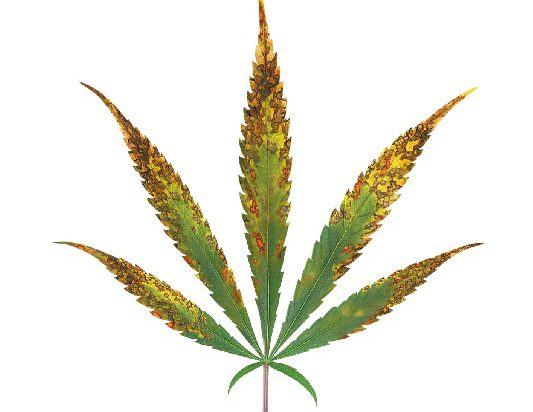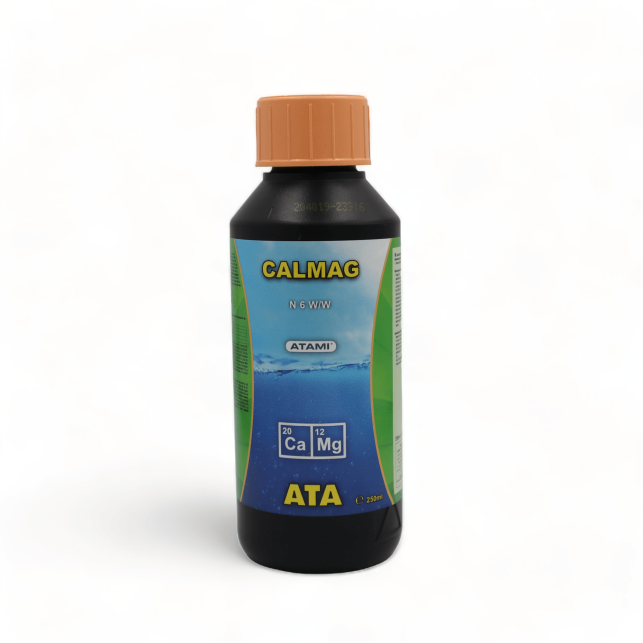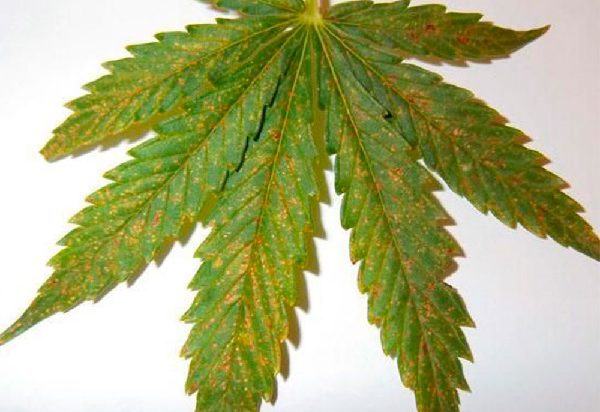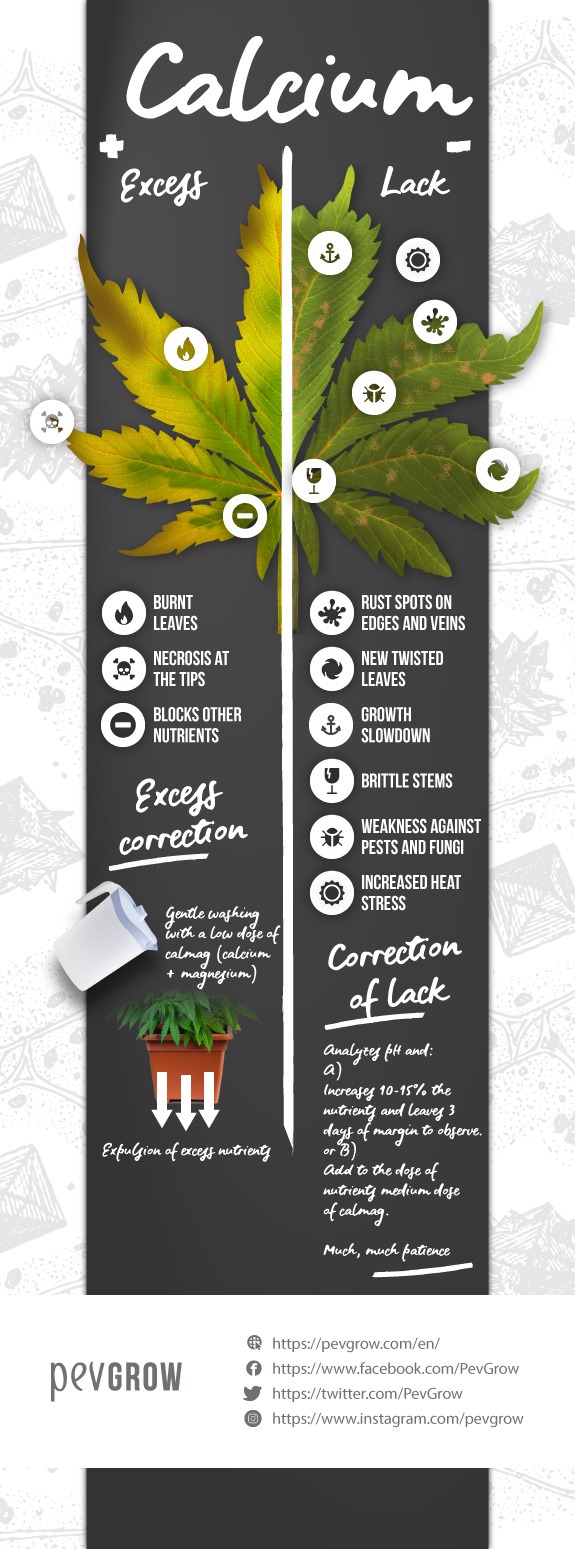

In constant struggle for the regulation of cannabis, mainly in the medicinal field.
17-05-2019 10:00:51 - Updated: 17 May, 2019
Dear grower, when you decided to start growing your own cannabis, did you believe that you’d become an amateur plant scientist? This is what it takes to be proficient with growing your own high-quality marijuana. Ask any grower that’s been in the business, and they’ll tell you its takes in-depth knowledge to produce those High Times looking buds.
What’s the most challenging aspect of growing weed isn’t all the information you need to process, it’s coping with the problems you’ll eventually have. No one is perfect, and this means you’ll subsequently scan through Google searching “how to fix x.” Been there, done that, and now it’s your turn. Let’s look through one of the biggest hurdles for newbies and veterans alike: Calcium.
⚠️ What is Calcium?
Calcium is an essential secondary macronutrient. It doesn’t make the cut to hang out with nitrogen, phosphorous, and potassium; but it has a wide range of responsibilities in plant health. Its group of secondary nutrients consists of magnesium and sulfur, and these three aren’t needed in a large quantity as the primary nutrients NPK.
➕ Calcium’s Role in Cannabis Plants
Calcium’s role should never be understated. It’s responsible for keeping cell walls intact and sending messages to activate cellular activities. It’s crucial for many enzymatic processes in cannabis plants. It plays a crucial role in protecting cannabis plants from heat stress.
The list goes on and on, but we’ll leave it here for now. What we want you to understand most of all, is that calcium is an essential nutrient and is responsible for a wide host of aspects with marijuana plant.
Cell walls are responsible for keeping the body of a plant rigid and functioning. Imagine your own body, where our skin is made up of cell walls. If you suddenly managed to destroy your cell walls, then you’d immediately fall apart. The same goes for plants and its with utmost importance that they remain working.
Heat stress is a common problem in the grow room. If a plant lacks a protective measure to shield itself from the heat of an HPS or MH lamp, then it won’t survive for very long. Calcium allows for cannabis plants to regulate themselves so they may continue functioning even in hot climates.
Enzymatic functions are responsible for a plethora of activities in marijuana plants. Enzymatic functions allow for functions such as cloning, apical dominance, the creation of new shoots, and many more. Without these enzymatic functions, we wouldn’t be able to manipulate cannabis plants into growing outwards to create a SCROG setup.
Can you imagine what the cannabis industry would look like if we couldn’t clone? We owe many thanks to calcium for its critical role in the overall functions related to the production of marijuana crops.
✅ The Basics of Calcium While Growing Weed
Now that we have a basic understanding of calcium let’s take a look at what you need to know when you’re growing cannabis.
Calcium isn’t a mobile nutrient when growing cannabis. Mobility/immobility of nutrients plays a critical role in understanding how to identify a calcium deficiency or toxicity. Calcium’s immobility means that when there’s a severe lack or abundant amount, the affected leaves will be new growth at the top of the plant.
Cannabis generally uptakes a lot of calcium and depending on the substrate used, you may need more or less of it.
🔥 Calcium and Growing Medium
Calcium impacts cannabis grown in both soil and soilless mediums. Cannabis that is grown in soil generally has a natural buffer that is found in the mix. This calcium buffer is usually in the form of dolomite lime, which is powdered.
This buffer keeps the pH of the soil in check, and not allowing drastic swings toward too acidic or too basic. This necessary calcium buffer maintains the pH in the perfect range of 6.8-7.2. This is the reason why cannabis plants growing in soil generally don’t require a pH meter. This is also the reason why marijuana plants that are grown in soil usually don’t have high instances of calcium deficiency or toxicity.
On the other hand, cannabis plants growing in a soilless or hydroponic system generally has a higher instance of calcium deficiency or toxicity. The reason for this is because calcium is only available for uptake in a certain pH range. Growing in a soilless medium requires the use of a pH meter for this reason.
An especially important aspect when growing cannabis in soilless mediums is the cation exchange capacity. This chemical exchange is responsible for some of the most significant headaches growers encounter.
Cation exchange is the function of specific cations, like calcium, to be held by the medium. This means that if the cation exchange capacity of calcium is not functioning correctly due to an excess of another nutrient, the medium may hold onto the calcium ions. Calcium ions that are held by the medium will not be able to be utilized by the marijuana plant.
👾 What Does Excessive Calcium Do?
Too much calcium in your weed plants can lead to some severe consequences. The most obvious problem that you’ll see if you overdo it with a calcium additive is leaf burn. The cannabis plant is reacting to the excessive levels of calcium and is trying to push it out from the leaf tips. This causes necrosis (death) of the leaf tips, and they will be a yellow/brown color.
Besides causing leaf burn, excess calcium doesn’t actually create such drastic symptoms as a deficiency. Instead, too much calcium in your cannabis plants will actually lead to problems in other nutrients, such as magnesium and potassium. This situation presents a very frustrating problem when growing cannabis. Too much calcium will lock out magnesium or potassium, and the only way to correct the problem is by first dealing with the calcium issue.
So, although you’re experiencing potassium and magnesium related symptoms, the actual root of the problem stems from too much calcium. Dealing with an excess calcium problem doubles or triples your work by making it necessary for you to also try and fix your magnesium and potassium issues. It can also lead you astray chasing other nutrients, while the calcium problem remains active..

✨ How to Correct Excessive Calcium in Your Cannabis Garden?
Once you’ve determined that you have excess calcium in your marijuana plants, it’s time for a gentle flush. When I say gentle, I mean a low dose of a balanced nutrient mix. When growers here the word “flush,” they think pouring liters of water through the medium to flush every nutrient out. This is inadvisable because you’re suddenly depleting the cannabis plant of all of its necessary nutrients to function.
Flushing with a low dosage of nutrients allows excess nutrients to be pushed out while leaving a smaller concentration. This method allows your plants to continue taking up critical nutrients for its growth.
Alternatively, you can flush your plant with a low dose of calmag, a combination of calcium and magnesium. By flushing with calmag, you decrease your chances of suddenly locking out potassium and magnesium.

Ata Calmag one of the most effective products when your plants need an extra supply of Calcium and Magnesium…
Contains a powerful cocktail of nutrients.
Give your plants a vigorous growth.
Additional dose of vitamins and minerals.
Improves the cell walls formation in the root system.
Use in soft water or demineralized crops.
Compatible with organic nutrients
⛳ What Does a Calcium Deficiency do?
A calcium deficiency is much more noticeable than toxicity. A calcium deficiency will always begin in new growth and the top half of the cannabis plant. The reason for this is because of calciums immobility, and this means it won’t travel to older leaf growth. So, a clear indicator of spotting a calcium deficiency is by evaluating what portion of your plant is being affected.
Visual indicators are light yellow and brown spots that look similar to rust. These spots will generally start near the edge of the leaves or near the veins. As the deficiency expands, these mottled colors will begin to envelop the entire leaf. New leaves will usually curl, and the topmost area of growth will slow down in vigor. Stems will suddenly become flimsy and fall off easily if brushed against. The overall growth of the plant will slow down drastically
A calcium deficiency in cannabis also drastically limits the plants’ ability to fight off pathogens and predators. This means that certain types of fungi and bacteria will be more likely to establish themselves in this time of weakness. Pests such as mites, whiteflies, and gnats will be readily attracted to plants that are already weak and unable to defend themselves.
Since cell walls are weak during a calcium deficiency, the overall plant’s wall structure is fragile. This makes the entire plant brittle and unable to support the weight of buds. Bud development is reduced, as well as the growth of the plant’s root system.
Also, calcium plays a significant role in helping a cannabis plant cope with heat stress. While a calcium deficiency is ongoing, a marijuana plant will be unable to cope with heat stress. This is compounded by the fact that the cell walls are already weakened.

⭐ How You Can Fix a Calcium Deficiency?
Now that you’ve spotted enough symptoms that’s lead you to believe you’re looking at a calcium deficiency, it’s time to act..
First, you’ll need to analyze the nutrients that you’ve been feeding your plants. Are you giving lower doses than what’s recommended? Are you checking pH? These should be the first questions that you answer.
If you realize that you are giving too small of a dose of nutrients, then it’s time to bump up your schedule. Start with a small increase of 10-15%. Allow 2-3 days to notice if the new leaves resume vigorous growth..
Another option is to use calmag specifically in addition to your current nutrient lineup. In this situation, it’s recommended that you cut the recommended dosage of your calmag in half. That means if your calmag bottle suggests 5mL per 4 liters, then cut it to 2.5mL per 4 liters.
If you realized you haven’t checked pH, then its time to do so. If you recognize that your pH is off in the too acidic or basic direction, then it’s time to correct your nutrient pH. You should be aiming for 6.8-7.2 in soil and 5.2-5.8 in hydro. Once you’ve adjusted your pH, then it’s time to start adding nutrients at the right level.
Of course, you won’t be seeing a change instantaneously. Patience is key in growing excellent weed, and when dealing with problems, patience is a virtue. If problems persist after 4-7 days, it’s time to increase the dosage of calmag or your base nutrient.

⚠️ Conclusion
Now you’ve learned why calcium is such an important nutrient, even though it’s called a secondary macronutrient. Calcium plays a wide amount of roles, and they are all necessary for the health and happiness of your plants. If you grow your cannabis with the objective of keeping all of these necessary nutrients in line, you’ll have a problem free grow.
Of course, having a problem free grow takes either a lot of luck or a high degree of experience. As a grower, you must keep your plant’s system well fed if you want it to produce high-grade cannabis. Having the necessary knowledge of the things that run your plant is crucial, and you’ll be a better grower for it.
For more information on growing cannabis, join us at Pevgrow to discover a wide range of topics, from nutrient issues to various growing systems.






This is very useful to know, when you say a gentle flush with Calmag, if there is an excess, how many litres should be used in say a 7 litre pot
The amount of **ATA Calmag** to use in a **7-liter pot** depends on:
1. **Your water source** (soft water vs. hard water)
2. **Your plant’s growth stage** (seedling, vegetative, flowering)
3. **Your base nutrients and feeding schedule**
### General Dosage for ATA Calmag:
– **Recommended dose:** **0.1 – 1 ml per liter** of water
– **For soft water or deficiencies:** Start at **0.5 – 1 ml per liter**
– **For normal supplementation:** **0.3 – 0.5 ml per liter**
### How Much for a 7L Pot?
Since you’re watering a **7-liter pot**, you’ll likely use **1-2 liters of water per feeding** (depending on plant size & substrate dryness).
– If using **1 liter of water** → **0.3 – 1 ml of ATA Calmag**
– If using **2 liters of water** → **0.6 – 2 ml of ATA Calmag**
### Tips for Best Results:
✅ **Start low** (0.3 ml/L) and increase gradually if needed
✅ **Monitor runoff EC levels** to avoid overfeeding
✅ **Adjust based on plant response** (yellowing, deficiencies, etc.)
Thanks
Can I use my own calcium and magnesium in my plant when made into a liquid and how much do I use in a 4 gallon pot
Hi Nancy,
You should use 2 parts calcium to 1 part magnesium in general.
Try throwing it out once and see if it gets better
Perfect piece of work you have done, this site
is really cool with good information.
Not sure of I have a calcium deficiency or what. But I have an outdoor lady I started she’s only a lil over a week old. But she fell over on a hot day I know I should of started her indoors but I didn’t lesson learned . But I staked her up an gave her some super thrive. She’s growing in soil fox farm ocean forest. Strain is Cali orange temp outside has been hot during the day up in the 90 degree zone. She is still alive but weak is there anything I can do? Do you think she will make it? Also I have some indoor ladies all autos growing in the same soil there about 3 weeks old I have them under a 600 watt led. My question is when I bought the led it was in my budget but I didn’t realize it doesn’t have any uv or ir do you think my plants will thrive an produce? They look healthy 3 Auto chem bubbly an 1 auto cheese temp 89 degrees light is about 24 inches from canopy. Also started feeding them grow booster purchased from ilgm. Will try an send a pic any thoughts or advice would be great thanks